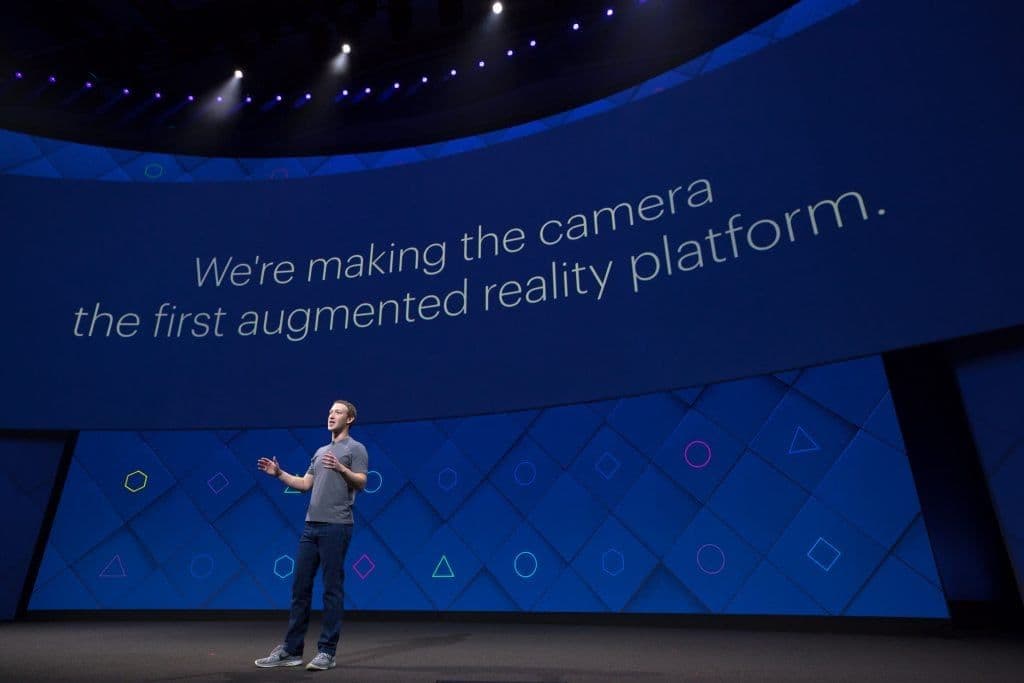We’re making the camera the first augmented reality platform.
— Mark Zuckerberg, Facebook F8 conference 2017
Facebook’s F8 conference was once again filled with incredibly exciting announcements.
Augmented reality (AR) could be seen as the main theme of this year’s conference. From augmented masks and special effects to 360 video camera to Facebook Spaces (an app where you can hang out with your family and friends virtually), Mark Zuckerberg and Facebook want to enable us to connect with one another on a deeper level through AR.
Besides AR, there were also announcements about Messenger, chatbots, Facebook Analytics, Facebook Live, and more!
We followed the conference for the past two days and would love to share the top 10 things we think social media marketers should take away from this F8 2017.
If you have been following the conference, too, we’d love to hear your thoughts and ideas about the amazing (and mind-blowing) announcements ?
10 Things Marketers Need to Know from F8 2017
We’ll go through each of the 10 major announcements and what it means to marketers, below. If you prefer watching a video instead, here’s a quick recap of the top three announcements:
1. Augmented Reality
The biggest announcement from the conference is that Facebook will be moving towards using augmented reality to connect us with our family and friends (and maybe brands).
Instead of sci-fi-looking glasses, Facebook believes that the camera will be the first mainstream augmented reality platform (think Pokemon GO).
All the cool camera features that Facebook has been releasing over the past few weeks is just the first act of its plan to integrate augmented reality into social media. Facebook has been working on a few augmented reality technologies that will allow individuals and brands to do fun and valuable things with its camera. Some examples are adding 3D objects to your camera view, turning a 2D photo into 3D, and adding a virtual information card to objects in your camera view (such as the wine bottle in the screenshot below).
(If you are curious about these technologies, check out the demos, which start at 19:22 of the keynote.)
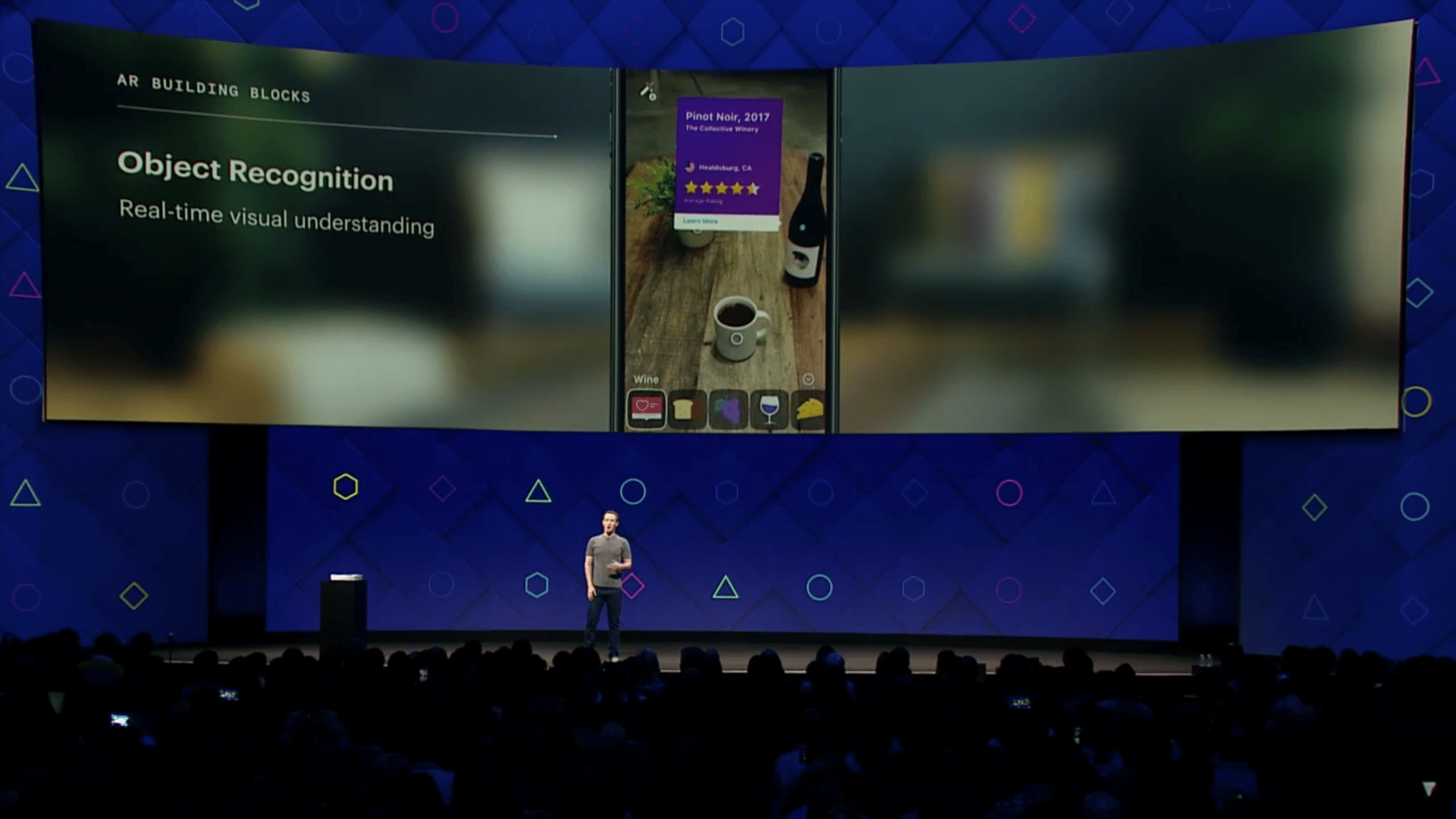
What it means for marketers:
When Facebook makes augmented reality mainstream (probably within the next two to three years), marketers will have an entirely new channel for reaching and connecting with their audience, just like when social media became mainstream many years back. The possibilities could be endless!
Personally, I like the example of tapping on an object in the camera view and having an information card pop up. According to Google, 82% of smartphone users research on their phones in stores before making their purchase. Augmented reality could change the way consumers research, shop, and interact with businesses.
At the moment, the best way to get started with augmented reality on Facebook might be to create (branded) masks and special effects for the Facebook camera. Let’s go through that next…
2. Camera Effects Platform
After Mark Zuckerberg shared his augmented reality vision, he launched the Facebook Camera Effects Platform — a platform that allows developers to create frames, masks, and special effects (or filters and lenses as we might be used to now) for the Facebook camera.
The two main products on this platform are Frame Studio and AR Studio.
- Frame Studio is an online creative editor that allows you to create frames for photos taken with the new Facebook camera or profile photos
- AR Studio is an application that lets you create animated masks and interactive effects for the new Facebook camera and Facebook Live
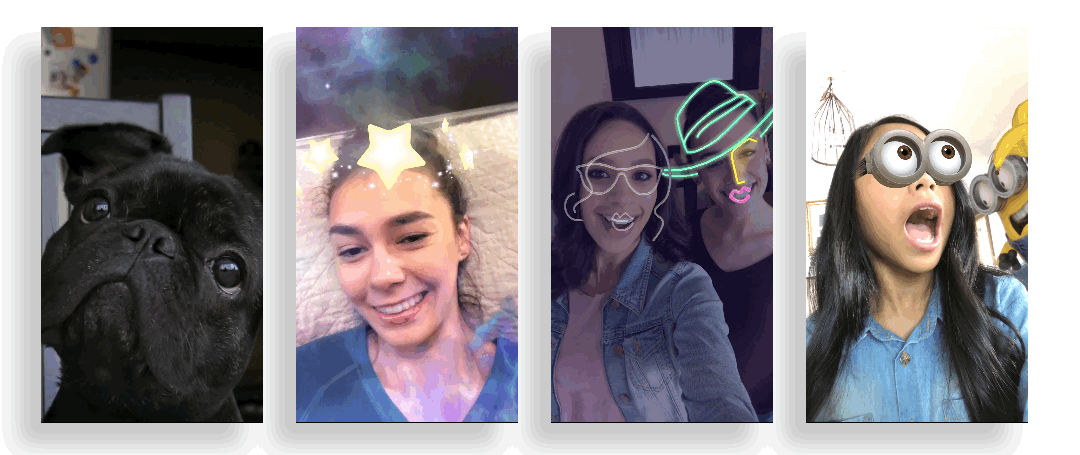
(From Facebook)
What it means for marketers:
Last year, The Information reported that people are sharing less on Facebook, with a decline of 21% in original personal content. With this new platform, Facebook might be looking to encourage users to share more by making sharing more fun.
If this trend were to pick up, it’d open up a great marketing opportunity for brands, just like Snapchat Geofilters did. Brands could create fun, relevant frames, masks, and special effects to reach their audience and then spread their reach when people share photos and videos with their creatives. The best part? It’s free to create these creatives on Facebook!
With the launch of Camera Effects Platform and Mark Zuckerberg’s special emphasis on camera as the first augmented reality platform, Facebook might push such content as much as it did with live videos over the past year.
3. Facebook Spaces
The next big announcement is the launch of Facebook Spaces — “a new VR app where you hang out with friends in a fun, interactive virtual environment as if you were in the same room”. It is now available in the Oculus Store.
With the acquisition of Oculus, Facebook wants to connect people beyond its mobile app but also in the virtual reality (VR). Facebook Spaces will allow us to hang out with our family and friends who are not physically nearby.
What it means for marketers:
It would probably be several years before social VR becomes mainstream (if it does) but it’d be great for marketers to start thinking about how marketing could be done in VR.
Looking at the video above, there could be several native and non-intrusive ways for brands to tap into the VR experience. Here’re some fun ideas I could think of:
- Travel agencies and tourism boards could let people explore certain places in VR before buying their tickets.
- Real estate companies could let potential buyers look at houses in VR before actually visiting the houses.
- Furniture companies could let customers “try out” furniture in their homes before purchasing.
- Clothes retailers could let customers “try out” clothes and chat with friends about them before buying, or even let them customize their avatars with their clothes.
- Education institutions and online learning platforms could let students attend classes together.
- And more!
Some of these might even be possible already with the new Facebook 360 camera.
4. Giphy + Facebook Live
In line with Facebook’s push for the camera to be the first augmented reality platform, Giphy launched three new products to make sharing GIFs even easier. The product that caught our attention the most was Giphy for Facebook Live.
With this new product, both you and your viewers can add GIFs to your live videos. This creates a fun, new way of engaging with your audience in real-time.
Here’s an example from a Giphy team member who went live from the F8 conference:
What it means for marketers:
Facebook has been ranking videos that are live higher on users’ news feed than when the videos are no longer live. This new feature could help increase engagement on your live videos and might help your videos rank (even) higher on your audience’s news feed.
Here’re the steps to activate this feature for your live video:
- Tap on the “Live” button in the Facebook app
- Tap on the magic wand in the upper-right corner
- Select “GIPHY LIVE”
- Tap “Go Live”
- Voilà!
When you are using the front camera (that’s facing you), there will be a ticker with hashtags that you can tap on to change the GIF. When you are using the back camera (that’s facing away from you), a microphone will appear as though you are interviewing someone.
5. Messenger Business Bots
There are now more than 100,000 chatbots on Messenger, up from 33,000 just last September. To help brands and consumers connect with each other better through such bots, Facebook released a series of updates during this year’s F8.
One of the updates is Chat Extensions, which allows multiple people to chat with the same business chatbot at the same time. For example, you could share songs from Spotify directly within your group conversation with the Spotify bot or make a holiday booking with your friends through the Kayak bot.
Another interesting update is that M, Messenger’s AI assistant, is now able to listen to your conversations and make relevant suggestions at the right time. For example, if you and your friends are talking about getting food, M would suggest playing an order through one of the food delivery bots.
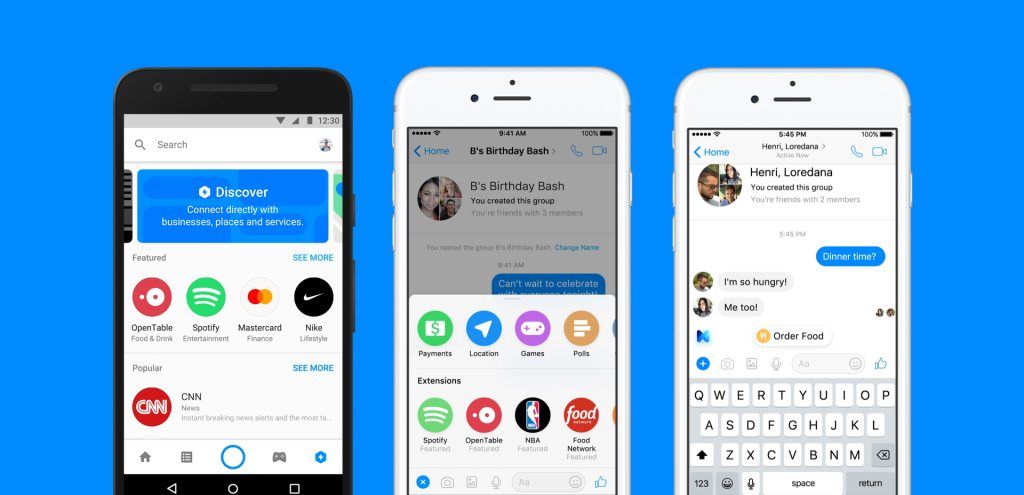
(From Facebook News Room)
What it means for marketers:
This provides another great channel for marketers to reach and connect with their audience. How amazing! Instead of commenting on your Facebook post or messaging you via Messenger, your customers might choose to chat with your bot — which will be around 24/7.
If you already have a bot for your Facebook Page, you can now use call-to-actions like “Get Support” or “Shop Now” to bring people to your bot.
The bonus about bots is that they can help automate tasks, which is especially helpful for small businesses that have fewer resources. If you have not explored the idea of having a chatbot for your business, now might be a great time to start. Here’s a comprehensive article about chatbot marketing by Matthew Barby of HubSpot.
6. Messenger Discover Tab
With more and more bots being built on the Messenger Platform, Facebook wants to help users discover the right bots for the things they want to do. So during this F8, David Marcus, VP of Messenger, introduced the new Discover Tab.
It is a new section in the Messenger app where people can discover and find bots, nearby places, and businesses to message.
What it means for marketers:
With more than 1.2 billion people using Messenger every month, the Discover Tab might become a significant source of traffic for your business. While chatbots are relatively new at the moment, it might be timely to hop onto this rising trend before it gets too crowded.
Once more businesses and bots are listed in the Discover Tab, marketers might have to start thinking of ways to increase their visibility in the Discover Tab (similar to how apps try to be featured on the App Store or Google Play).
7. Parametric QR codes
Facebook is also trying to help people discover businesses in the physical world and enrich their experiences. By scanning the new parametric QR codes with the Messenger camera, people can find out more information about an event or business through a Messenger bot.
During the keynote, David Marcus showed how the Golden State Warriors are implementing several QR codes in their stadium that’d offer different experiences to their fans.
What it means for marketers:
This creates another touch point between your customers and your business, which is a great opportunity for you to provide extra value to them.
For example, if you are organizing a conference, you could create multiple QR codes for the conference. Your attendees would be able to scan your QR codes with their Messenger camera to receive a welcome message, find out the conference schedule, or see frequently asked questions about the conference.
If you are a physical retail store or a restaurant, you could create QR codes that would bring up your bots to assist your customers while they shop or dine.
8. Smart Replies for Pages
One of the challenges small businesses have is replying to all the messages they receive. With Smart Replies, Facebook wants to help small businesses automate some of the customer support processes.
Using AI, Smart Replies helps Page owners to respond to the most frequently asked questions that they receive, such as business hours, directions, and contact details. The AI would grab information from the Pages, detect the questions asked, and reply with the appropriate information.
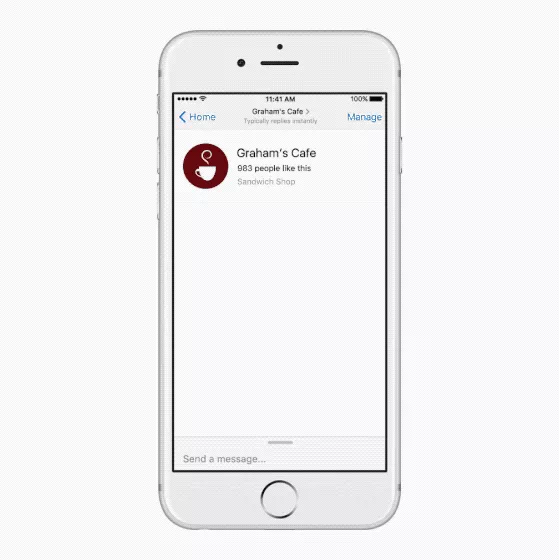
(From Fast Company)
What it means for marketers:
Social media managers often have to juggle executing their social media strategy with answering customer support questions on social media. One great benefit of Smart Replies is that it can help free up some of your time for you to create high-quality content and engage with your audience on social media.
As the AI would grab information from your Page, it’ll be great to keep your Page information updated.
9. Facebook Analytics
Facebook Analytics, Facebook’s analytics platform previously only for apps, will now be providing analytics for Facebook Pages and offline conversions, too. This omnichannel analytics will allow businesses to measure and understand their customers’ full journey from interactions on their Facebook Pages to purchasing on their website.
This AI-powered analytics can automatically report trends and anomalies. Instead of spending a lot of time searching for the right data, Facebook Analytics will serve valuable insights directly to you.
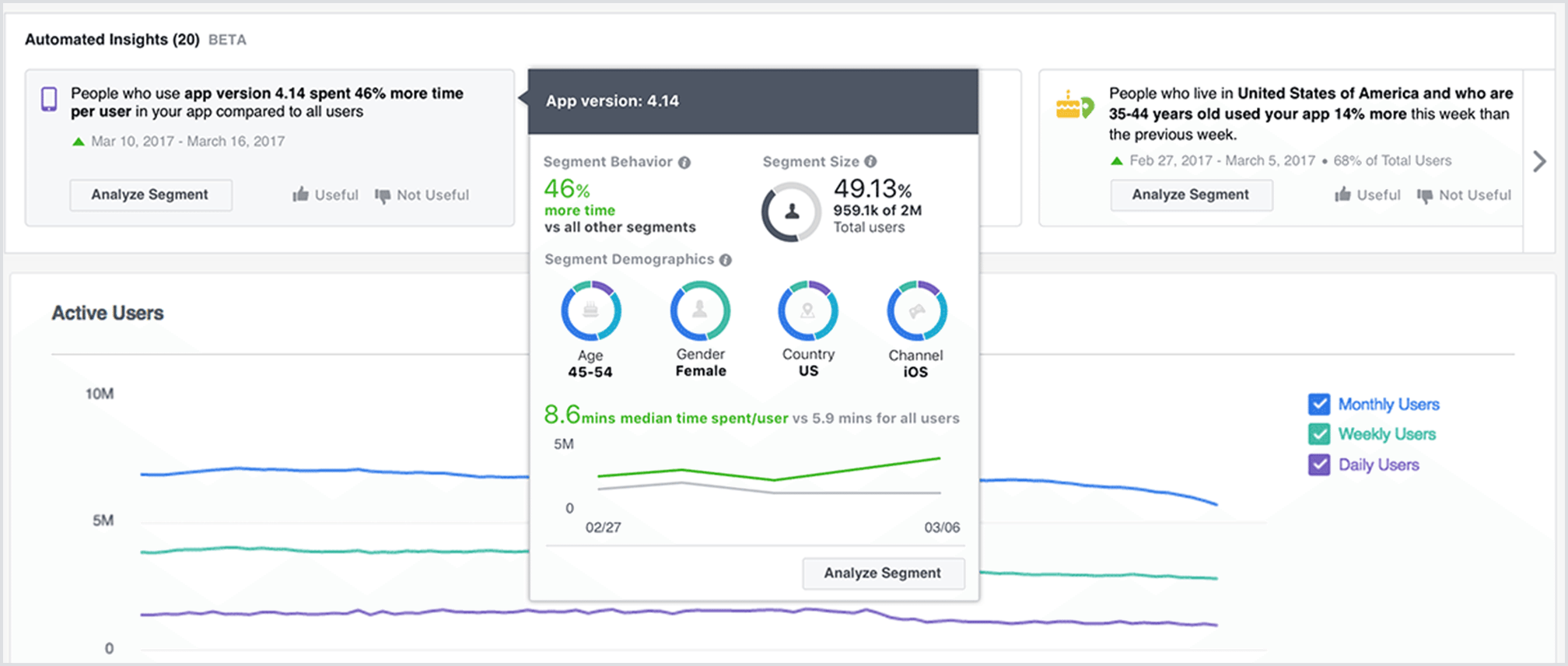
(From Facebook Analytics blog)
What it means for marketers:
Facebook Analytics might become the new Google Analytics for social media marketers. While Google Analytics is great for web analytics, Facebook Analytics has an advantage of tying in data from Facebook. This will make it easier for marketers to prove the ROI of being on social media, particularly Facebook. For instance, you can evaluate if people who commented on an item in your Facebook post are more likely to visit your website to purchase the item.
You can now also create custom audiences based on people’s activities on your Facebook Page, app, website, or bot. This will allow you to reach more specific segments of your target audience through Facebook ads. For example, you could show your ads to people who have visited your website and interacted with your chatbot.
10. Global Connectivity
Facebook is moving from connecting family and friends to building communities. And building communities that work for everyone starts with building connectivity that works for everyone, according to Director of Connectivity Programs, Yael Maguire.
Teams at Facebook have been working on several projects such as the Aquila and Terragraph to provide fast and stable internet access to everyone everywhere.
What it means for marketers:
Facebook currently reaches about a third of the human population, and its goal is to connect the entire world — every single human being. Facebook still has a massive growth opportunity in terms of users and so it behooves marketers to continue to iterate on Facebook marketing tactics and focus on audience growth and engagement.
Over to You
From short-term projects (e.g. augmented reality) to medium-term developments (e.g. virtual reality) to long-term plans (e.g. global connectivity), Facebook seems to have all bases covered.
As one of the biggest tech companies around, Facebook has a huge impact on the way we live our lives and, consequently, the way we interact with our audience and market our products. It’s amazing how much work Facebook has done to make social media marketing more effective (and fun).
It’d be great to hear your thoughts on all these major announcements (and those that I have not covered such as brain technology).
- What are you most excited about?
- What do you think about these announcements?
- How do you think each of the developments will impact us marketers?
Thank you!
—
The featured image was taken from Facebook News Room.
Try Buffer for free
190,000+ creators, small businesses, and marketers use Buffer to grow their audiences every month.

